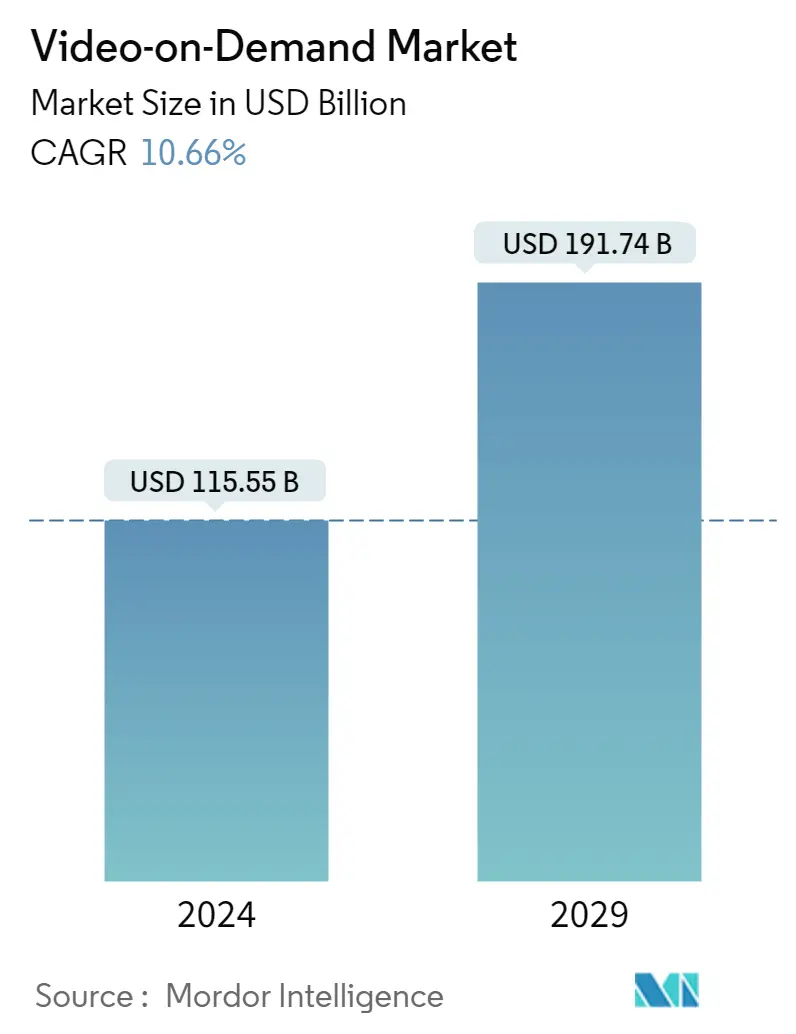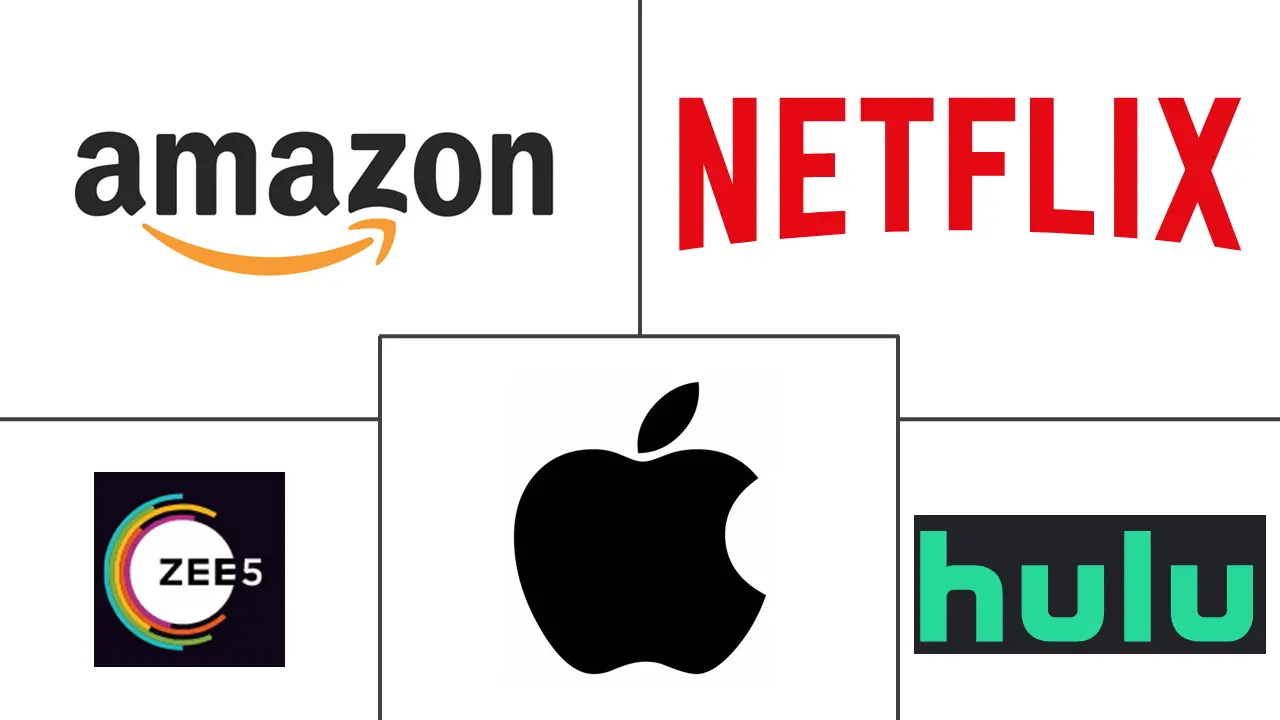Market Size of Video-on-Demand Industry

| Study Period | 2019 - 2029 |
| Market Size (2024) | USD 115.55 Billion |
| Market Size (2029) | USD 191.74 Billion |
| CAGR (2024 - 2029) | 10.66 % |
| Fastest Growing Market | Asia Pacific |
| Largest Market | North America |
Major Players
*Disclaimer: Major Players sorted in no particular order |
Video on Demand Market Analysis
The Video-on-Demand Market size is estimated at USD 115.55 billion in 2024, and is expected to reach USD 191.74 billion by 2029, growing at a CAGR of 10.66% during the forecast period (2024-2029).
- Fundamental factors, such as uninterrupted connectivity, mobile devices as a primary source of content consumption, and advanced capabilities of smartphones are likely propelling the video-on-demand market.
- Video-on-demand services gained popularity in the past few years due to the increasing use of OTT platforms, such as Netflix, Amazon Prime, and others. The presence of these businesses and the widespread accessibility of cloud platforms contributed significantly to the market's growth.
- The surging demand for digital media devices and the availability of faster internet to access media content remotely, along with the rapid adoption of mobile phones, owing to the growing popularity of social media platforms, drive the growth of the video-on-demand market. Recent technological developments and increasing penetration of the internet in several countries over the globe allow video-on-demand service providers to offer high-quality content. At the same time, the launch of new shows and movies on these platforms during the pandemic contributed to the growth of SVoD services.
- Developments in the digital video landscape, especially with premium video advertising, continue to grow with the ad views on streaming services. Ad views increased by 45% because viewers embraced ad-supported digital video content. A recent study found that U.S. audiences use upwards of seven video streaming services via ad-supported and ad-free subscriptions, which drives the Video-on -demand services. The industry has shifted its focus on user experience from content. However, in countries like India, specific customized regional content will play an essential role in driving the video demand market.
- Increasing concerns among market players about video content piracy and protection are expected to hinder the video-on-demand market growth and may lead to substantial revenue loss. As a result, the number of viewers watching content may decline. For instance, according to a joint Digital Citizens Alliance-NAGRA study, the pirate subscription IPTV service is being used by around 9 million subscribers in the United States.
- The COVID-19 pandemic led to the lockdown all over the world. Due to the limits on travel during the pandemic, there has been a beneficial effect on the video-on-demand business due to the lockdown. Consumers all around the world are increasingly streaming entertainment. According to predictions made by Rapid TV News, the COVID-19 pandemic crisis would increase the number of SVoD users worldwide by 5% and reach 949 million. Following the pandemic, the growing popularity of advanced networking technologies would support industry expansion.
Video on Demand Industry Segmentation
Video on demand is a technology that enables users to stream video content over the internet on computers, televisions, and mobile devices through applications, such as OTT platforms, without the constraint of time. This includes a fee-based business model, transactional video-on-demand (TVoD), subscription video-on-demand (SVoD), and others. The video content comes from various categories: media and entertainment, education and training, health and fitness, and others.
The video-on-demand market for the study defines revenues generated from the business model, such as transactional video-on-demand (TVoD), subscription video-on-demand (SVoD), and other business models across the globe. The study also analyses the overall impact of the COVID-19 pandemic on the ecosystem. The study includes qualitative coverage of the most adopted strategies and an analysis of the key base indicators in emerging markets.
The video-on-demand The market is segmented by business model (transactional video-on-demand (TVoD) and subscription video-on-demand (SVoD)) and geography (North America, Europe, Asia Pacific, the Middle East and North Africa, and the Rest of the World). The market sizes and forecasts are provided in terms of value (USD) for all the segments.
| By Business Model | |
| Subscription Video-on-demand (SVoD) | |
| Transactional Video-on-demand (TVoD) | |
| Other Business Models |
| By Geography | |
| North America | |
| Europe | |
| Asia Pacific | |
| Middle East and Africa | |
| Rest of the World |
Video-on-Demand Market Size Summary
The video-on-demand (VoD) market is experiencing significant growth, driven by factors such as uninterrupted connectivity, the rise of mobile devices as primary content consumption tools, and the advanced capabilities of smartphones. The increasing popularity of over-the-top (OTT) platforms like Netflix and Amazon Prime, along with the widespread accessibility of cloud services, has substantially contributed to the market's expansion. The demand for digital media devices and faster internet access has further propelled the market, enabling high-quality content delivery. The COVID-19 pandemic acted as a catalyst, with lockdowns leading to a surge in streaming as consumers sought entertainment at home. This shift has been supported by technological advancements and the growing penetration of the internet, allowing VoD providers to offer a diverse range of content.
In North America, particularly the United States and Canada, the VoD market is thriving due to factors such as content personalization, flexibility, and the availability of diverse content. The transition from 4G to 5G networks is enhancing consumer experiences with higher-resolution videos, further driving adoption. Major players like Netflix, Amazon, Disney+, and Apple Inc. dominate the market, employing strategies like original content production and partnerships to maintain their competitive edge. The market is characterized by a mix of global and regional players, with ongoing collaborations and licensing deals expanding content offerings. Despite challenges like content piracy, the VoD market continues to present lucrative opportunities for growth and consolidation, as evidenced by recent strategic partnerships and service expansions.
Video-on-Demand Market Size - Table of Contents
-
1. MARKET INSIGHTS
-
1.1 Market Overview
-
1.2 Industry Value Chain Analysis
-
1.3 Industry Attractiveness - Porter's Five Forces Analysis
-
1.3.1 Bargaining Power of Buyers
-
1.3.2 Bargaining Power of Suppliers
-
1.3.3 Threat of New Entrants
-
1.3.4 Threat of Substitutes
-
1.3.5 Intensity of Competitive Rivalry
-
-
1.4 Impact of COVID-19 on the Market
-
1.5 Key Metrices
-
1.5.1 User Penetration Rate
-
1.5.2 Average Revenue Per User
-
-
-
2. MARKET SEGMENTATION
-
2.1 By Business Model
-
2.1.1 Subscription Video-on-demand (SVoD)
-
2.1.2 Transactional Video-on-demand (TVoD)
-
2.1.3 Other Business Models
-
-
2.2 By Geography
-
2.2.1 North America
-
2.2.2 Europe
-
2.2.3 Asia Pacific
-
2.2.4 Middle East and Africa
-
2.2.5 Rest of the World
-
-
Video-on-Demand Market Size FAQs
How big is the Video-on-Demand Market?
The Video-on-Demand Market size is expected to reach USD 115.55 billion in 2024 and grow at a CAGR of 10.66% to reach USD 191.74 billion by 2029.
What is the current Video-on-Demand Market size?
In 2024, the Video-on-Demand Market size is expected to reach USD 115.55 billion.

